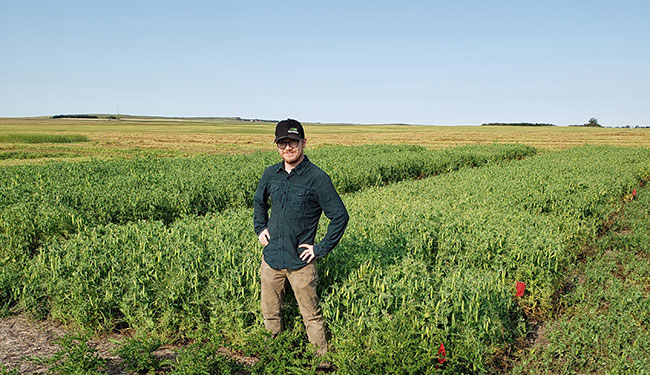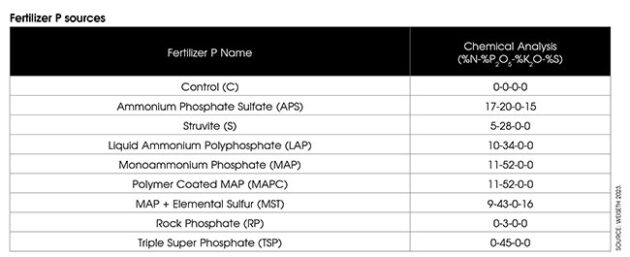
Features
Pulses
Investigating 4R strategies for field pea
Searching for the balance of crop nutrient uptake and mitigating phosphorus losses.
February 21, 2024 By Bruce Barker
 Blake Weiseth is investigating 4R strategies for phosphorus.
Photos courtesy of Blake Weiseth.
Blake Weiseth is investigating 4R strategies for phosphorus.
Photos courtesy of Blake Weiseth. What’s the correct fertilizer phosphorus (P) source, placement and rate for field pea? With new P fertilizer sources recently becoming available, that question is even more relevant today.
“We still struggle to come up with the correct combination of 4R practices due to a number of factors. One is that few studies have investigated the agronomic and environmental performance of some of these new and existing fertilizer P sources under our Canadian Prairie conditions,” says Blake Weiseth, a PhD candidate in the Department of Soil Science at the University of Saskatchewan, under the supervision of professors Jeff Schoenau and Jane Elliott.
Weiseth further adds that consideration of landscape and soil properties may help benefit the site-specific prescriptions of 4R nutrient stewardship in field peas. His research is running from 2021 through 2023, with the third and final year’s analysis being conducted on the 2023 canola crop. In 2022, it looked at how 4R practices influenced pea yield, nutrient uptake and residual soil P, along with the environmental risk of the loss of soluble P in snowmelt water.
The study has three sites with different landscape characteristics: Central Butte Upslope, Central Butte Lowslope and Langham Midslope (level topography). A low P rate of 17.8 lbs P2O5/ac (20 kg P2O5/ha) is being compared to a high rate of 35.6 lbs P2O5/ac (40 kg P2O5/ha). The two fertilizer placements compared are a sideband at seeding and surface broadcast incorporated immediately before seeding.
Each site was deficient in P with the modified Kelowna P soil test levels in the seven to eight ppm range. Organic carbon was relatively low at 1.5 per cent at the CB Upslope, 2.6 per cent at Langham Midslope and 2.7 per cent at CB Lowslope. The pH at each site was seven at CB Upslope, 7.3 at CB Lowslope and 7.6 at Langham Midslope.
Eight different P sources plus a control were applied, with basal applications of nitrogen (N), potassium (K) and sulfur (S) across all treatments to account for differences in the analysis of the fertilizer products. Some of the P fertilizers would be considered as slow-release sources such as polymer-coated monoammonium phosphate and struvite. Rock phosphate would be considered to have very low plant availability.
“Struvite is extracted from municipal waste sources and has environmentally friendly benefits associated with it,” says Weiseth.
In 2021, responses of the wheat crop grown were impacted by drought conditions. Ammonium phosphate sulfate had significantly higher P uptake than the other sources at CB Upslope, and struvite and the control were statistically the lowest. The other sources were intermediate. At the two other sites, there weren’t any statistical differences between sources, but the results followed a similar trend as CB Upslope.
At each site in 2021, total P uptake was statistically higher for sideband placement than broadcast incorporated.
The amount of P in snowmelt runoff varied somewhat by P source. Rock phosphate and the control had the lowest P runoff at all sites, which, Weiseth says, was to be expected because of the low solubility of rock phosphate. Langham Midslope had some of the highest runoff values, with the control and rock phosphate the lowest and struvite and MAP intermediate.

No yield response
The growing conditions in 2022 were better than 2021 but were still somewhat drought impacted. In 2022, peas were grown on the wheat stubble. There were limited impacts of the fertilizer source on pea grain and straw yield at all three sites. No significant differences in yield were observed among P sources compared to the control without added P.
“There was a trend for higher yield with ammonium phosphate sulfate at both Central Butte sites and a higher yield at Langham with MAP +ES,” says Weiseth. “Conversely, there was a trend to lower yield with Polymer Coated MAP and rock phosphate at all three sites.”
Measurements of soil available P in fall 2021 after the wheat crop found that ammonium phosphate sulfate had the highest values across all three sites, indicating higher residual P availability while rock phosphate had the lowest. The Langham site also had the lowest residual soil test P levels. Weiseth explains that the lower levels at Langham could be related to the higher pH level in the soil.
“Phosphorus availability in the soil peaks around 6.5 pH. When pH increases to 7.5, as at the Langham site, a smaller proportion of P in the soil is plant available,” says Weiseth. “Managing phosphorus fertility can be challenging under calcareous, high pH soils.”
With two years of data analyzed, Weiseth sees some trends. The first is that peas had less response to fertilizer P form and rate compared to wheat, as shown in the 2022 data, and these results agree with previous research. There were also no differences in yield response between the low and high fertilizer P application rates.
“Peas are well-known scavengers of soil P due to their ability to modify the soil rhizosphere, so we didn’t really expect to see a large yield response,” says Weiseth.
He says the yield results can be viewed from two perspectives. “On one hand, we might be discouraged by the lack of pea yield response to fertilizer P. On the other hand, we can also view this positively and leverage pea’s ability to scavenge soil P so that pea might be viewed as an important rotational crop with some of the high input prices we are seeing today.”
With the preliminary results, Weiseth says there was a trend for the ammonium phosphate sulfate source having higher yield, high P uptake and high residual soil P. He says previous research supports this trend because sulfur may improve P availability in calcareous soils due to its acidifying effect in the soil.
Coated MAP and rock phosphate trended to lower yield, lower P uptake, and low residual soil test P. Langham, with its high pH, also consistently had low yield, low P uptake and low residual P.
Weiseth is looking forward to analyzing the results after three successive years of P fertilizer application and the impact on the 2023 canola crop, which is typically a more responsive crop than peas. An interesting aspect is whether the less soluble sources will become increasingly available over time and could possibly be used as a P-building strategy for deficient soils.
“For rock phosphate [the least soluble source], we have seen that even two years of application has not caused statistically significant increases in soil test P levels compared to the control treatment. For sparingly soluble P sources, like struvite, we see a statistically significant increase in soil P over time compared to the control treatment, so I can see this as a potential strategy to build soil P,” says Weiseth. “As struvite is less soluble than MAP, we can also apply higher rates of this product in or near the seed-row with less risk of seedling toxicity compared to MAP, so this can also be leveraged for those wanting to build soil P.”